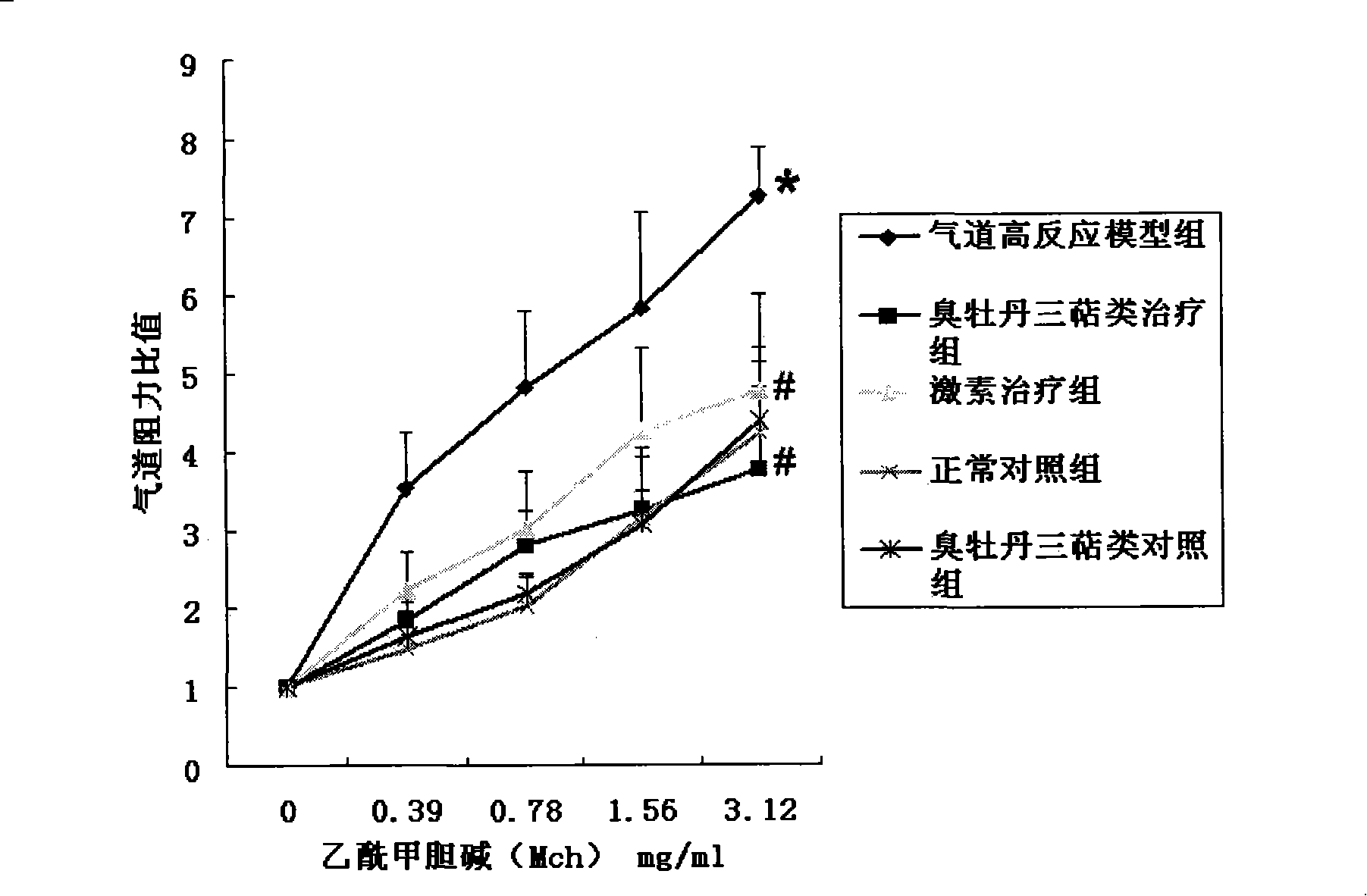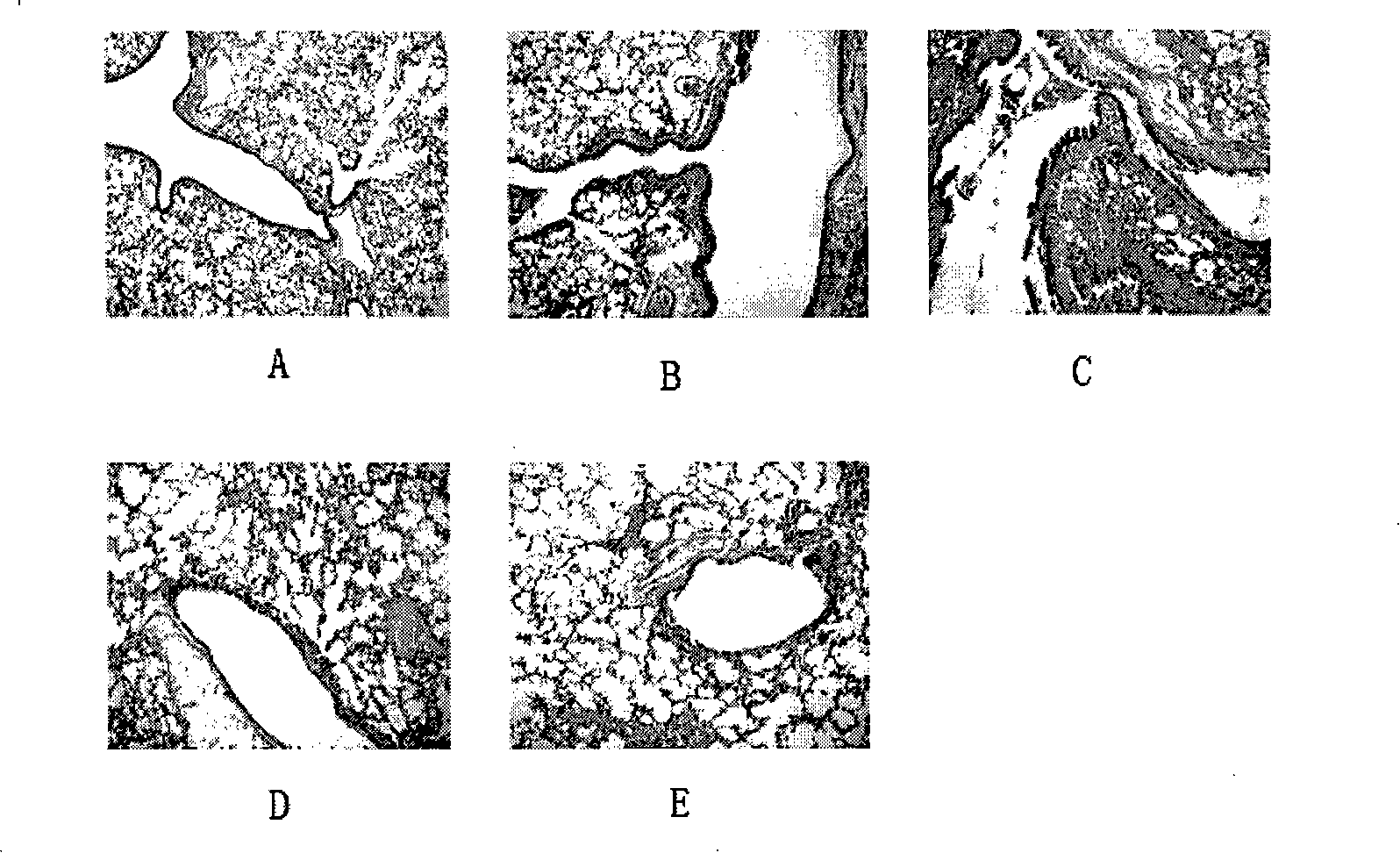Clerodendrum bungei extract and use thereof for treating airway hyperreactivity
A technology of airway hyperresponsiveness and stinky peony, which is applied to respiratory diseases, drug combinations, plant raw materials, etc., and can solve problems that do not involve airway inflammation or airway hyperresponsiveness, and have few active ingredients
- Summary
- Abstract
- Description
- Claims
- Application Information
AI Technical Summary
Problems solved by technology
Method used
Image
Examples
Embodiment 1
[0016] Example 1: Separation and preparation of triterpenoid extracts of smelt peony
[0017] Wash and dry the whole wild peony plant, weigh 100 grams, cut into pieces and add to a 2L round bottom flask, add 1L of 50% ethanol; place the round bottom flask in a water bath at 82°C and heat and reflux for 4 hours. Recover the reflux liquid. Then add 1L of 50% ethanol and repeat the above operation once. Then combine the extracts, pour them into a beaker, concentrate and evaporate to dryness; add 200ml of double-distilled water and stir to form a suspension; then extract twice with 200ml of petroleum ether, separate and discard the extract, and then extract twice with 200ml of chloroform. The chloroform extract is recovered. Take 0.1ml from the chloroform extract for pre-test inspection of its composition, and the rest is concentrated and evaporated to dryness. The concentrate is weighed, about 0.7g.
[0018] Then the concentrate is made into an emulsifier, and the method is as foll...
Embodiment 2
[0023] Example 2: The effect of triterpenoid extract of odorous tree peony on a mouse model of airway hyperresponsiveness
[0024] 1. Animal grouping and treatment: 50 Kunming mice were randomly divided into 5 groups. The way of administration is gavage, the gavage amount is 1ml / 100g body weight.
[0025] ① Normal control group: Gavage with normal saline once a day for 7 consecutive days;
[0026] ②Smelly tree peony triterpenoid control group: gavage the odor of tree peony triterpenoid emulsifier once a day for 7 consecutive days;
[0027] ③Airway hyperresponsiveness model group: Gavage with normal saline every night for 7 consecutive days, and attack with ozone every afternoon for 20 minutes from the third day of gavage for 5 consecutive days;
[0028] ④ Hormone treatment group (positive control): gavage 0.5 mg / ml glucocorticoid every night for 7 consecutive days, and attack with ozone every afternoon for 20 minutes on the third day of gavage for 5 consecutive days;
[0029] ⑤Smelly pe...
Embodiment 3
[0050] Example 3: Preparation of a medicinal preparation containing triterpenoid extract of odorous peony
[0051] Take the triterpenoid extract of Paeonia odorifera in Example 1, and prepare various pharmaceutically acceptable pharmaceutical compositions in various forms according to conventional methods known in the art:
[0052] Granules: Separately take the odorous peony triterpenoid extract, solidify the microcrystalline cellulose and starch and mix them evenly, use hypromellose as a binder to wet granulate, and dry the granules at 80 degrees Celsius to obtain odor Granules of peony triterpenoid extract.
[0053] Pellets: take the triterpenoid extract of odorous tree peony, respectively solidify by microcrystalline cellulose and starch, and mix them evenly with auxiliary materials. Use hypromellose as the binder and blank pill core as the substrate to prepare a diameter of 0.5 ~1.4 Pellets.
[0054] Capsules: Take the triterpenoid extracts of odorous tree peony, respectively sol...
PUM
 Login to View More
Login to View More Abstract
Description
Claims
Application Information
 Login to View More
Login to View More - R&D
- Intellectual Property
- Life Sciences
- Materials
- Tech Scout
- Unparalleled Data Quality
- Higher Quality Content
- 60% Fewer Hallucinations
Browse by: Latest US Patents, China's latest patents, Technical Efficacy Thesaurus, Application Domain, Technology Topic, Popular Technical Reports.
© 2025 PatSnap. All rights reserved.Legal|Privacy policy|Modern Slavery Act Transparency Statement|Sitemap|About US| Contact US: help@patsnap.com



